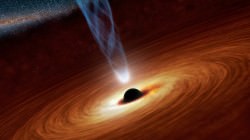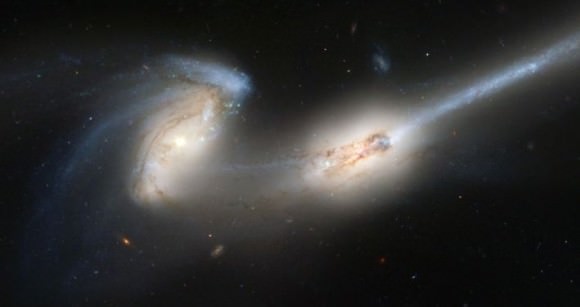Imagine a really bad day. Perhaps you’re imagining a day where the Sun crashes into another star, destroying most of the Solar System.
No? Well then, even in your imagination things aren’t so bad… It’s all just matter of perspective.
Fortunately for us, we live in out the boring suburbs of the Milky Way. Out here, distances between stars are so vast that collisions are incredibly rare. There are places in the Milky Way where stars are crowded more densely, like globular clusters, and we get to see the aftermath of these collisions. These clusters are ancient spherical structures that can contain hundreds of thousands of stars, all of which formed together, shortly after the Big Bang.
Within one of these clusters, stars average about a light year apart, and at their core, they can get as close to one another as the radius of our Solar System. With all these stars buzzing around for billions of years, you can imagine they’ve gotten up to some serious mischief.
Within globular clusters there are these mysterious blue straggler stars. They’re large hot stars, and if they had formed with the rest of the cluster, they would have detonated as supernovae billions of years ago. So scientists figure that they must have formed recently.
How? Astronomers think they’re the result of a stellar collision. Perhaps a binary pair of stars merged, or maybe two stars smashed into one another.
Professor Mark Morris of the University of California at Los Angeles in the Department of Physics and Astronomy helps to explain this idea.
“When you see two stars colliding with each other, it depends on how fast they’re moving. If they’re moving at speeds like we see at the center of our galaxy, then the collision is extremely violent. If it’s a head-on collision, the stars get completely splashed to the far corners of the galaxy. If they’re merging at slower velocities than we see at our neck of the woods in our galaxy, then stars are more happy to merge with us and coalesce into one single, more massive object.”
There’s another place in the Milky Way where you’ve got a dense collection of stars, racing around at breakneck speeds… near the supermassive black hole at the center of the galaxy.
This monster black hole contains the mass of 4 million times the Sun, and dominates the region around the center of the Milky Way.

“The core of the Milky Way is one of those places where you find the extremes of nature. The density of stars there is higher than anywhere else in the galaxy,”Professor Morris continues. “Overall, in the center of our galaxy on scales of hundreds of light years, there is much more gas present than anywhere else in the galaxy. The magnetic field is stronger there than anywhere else in the galaxy, and it has it’s own geometry there. So it’s an unusual place, an energetic place, a violent place, because everything else is moving so much faster there than you see elsewhere.”
“We study the stars in the immediate vicinity of the black hole, and we find that there’s not as many stars as one might have expected, and one of the explanations for that is that stars collide with each other and either eliminate one another or merge, and two stars become one, and both of those processes are probably occurring.”
Stars whip around it, like comets dart around our Sun, and interactions are commonplace.
There’s another scenario that can crash stars together.
The Milky Way mostly has multiple star systems. Several stars can be orbiting a common center of gravity. Many are great distances, but some can have orbits tighter than the planets around our Sun.
When one star reaches the end of its life, expanding into a red giant, It can consume its binary partner. The consumed star then strips away 90% of the mass of the red giant, leaving behind a rapidly pulsating remnant.
What about when galaxies collide? That sounds like a recipe for mayhem.
Surprisingly, not so much.
“That’s actually a very interesting question, because if you imagine two galaxies colliding, you’d imagine that to be an exceptionally violent event,’ Professor Morris explains. “But in fact, the stars in those two galaxies are relatively unaffected. The number of stars that will collide when two galaxies collide is possibly counted on the fingers of one or two hands. Stars are so few and far between that they just aren’t going to meet each other with any significance in a field like that.”

“What you see when you see two galaxies collide, however, on the large scale, is that the tidal forces of the two galaxies will rip each of the galaxies apart in terms of what it will look like. Streams of stars will be strewn out in various directions depending on the precise history of the interaction between the two galaxies. And so, eventually over time, the galaxies will merge, the whole configuration of stars will settle down into something that looks unlike either of the two initially colliding galaxies. Perhaps something more spheroidal or spherical, and it might look more like an elliptical galaxy than the spiral galaxy that these two galaxies now are.”
Currently, we’re on a collision course with the Andromeda Galaxy, and it’s expected we’ll smash into it in about 4 billion years. The gas and dust will collide and pile up, igniting an era of furious star formation. But the stars themselves? They’ll barely notice. The stars in the two galaxies will just streak past each other, like a swarm of angry bees.
Phew.
So, good news! When you’re imagining a worse day, you won’t have to worry about our Sun colliding with another star. We’re going to be safe and sound for billions of years. But if you live in a globular cluster or near the center of the galaxy, you might want to check out some property here in the burbs.
Thanks to Professor Mark Morris at UCLA – visit their Physics and Astronomy program homepage here.


I’ve always been curious. When galaxies merge and stars are ejected at high speed, what if anything happens to the planets around an ejected star?
Do they get thrown away from their star, do their orbits get perturbed so that some crash into the star while others are flung out of the system, or do they pretty much just stay where they are while streaking through space?
Try this Rogue Star and see.